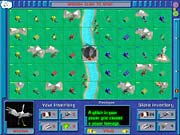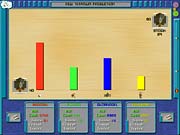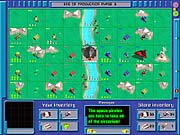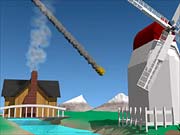It's the most boring of gaming clichés to wish that some company would just redo some old classic game with updated graphics, but that doesn't stop gamers from saying it all the time. This is often followed by the observation that in the old days of gaming, "it was all about the gameplay." Unfortunately, they usually can't test these hypotheses on the spot, so after a round of vigorous nods and an uncomfortable pause, these gamers move on to other topics of conversation. With the release of Gilligames' budget-priced title Space HoRSE, this old gaming cliché can finally be tested scientifically.

Space HoRSE is, for all intents and purposes, M.U.L.E., the classic game released first for the Atari in 1983, and long admired but rarely imitated since. There are a few changes, but in the end the only reason this game isn't named "M.U.L.E. 2002" is a legal one. By remaking M.U.L.E. almost two decades after the original's release, Space HoRSE exposes the nineteen-year-old gameplay to harsh scrutiny unimpeded by nostalgia. It's probably evidence of a deserved-yet-unawarded Nobel Prize for original programmers Dan Bunten, Bill Bunten, Alan Watson, and Jim Rushing that the gameplay holds up as well as it does.
As in M.U.L.E, Space HoRSE takes place on a 9x5 rectangular playing grid representing an uninhabited planet which you and three others (either AI or human opponents) are to colonize. You do so by claiming individual plots from the 44 available (the center is occupied by the warehouse) and developing either food, power, titanium, or zirconium production on your land plots through the use of robots. The mechanics are incredibly simple: each player claims a plot of land, runs around setting up resource-gathering stations called HoRSEs (which are essentially the same as M.U.L.E.s from the original Atari game), gets credit for various commodities produced, and then trades these on the open market. This happens each turn for twelve turns, at which point the wealthiest player (in terms of land, money, and commodities) wins.

Space HoRSE handles all of these mechanics just fine, although it could do a better job showing what the other players have done during their turns. (You can click through your opponents' turns at your leisure, but their new HoRSEs appear quickly and can be difficult to notice.) The graphics are decent, but only just so, and the sound is acceptable in the spirit of a time when getting multi-voice music out of a computer speaker was notable in itself. The real appeal of M.U.L.E. (besides any fond memories you may have of playing the game years ago) and also of Space HoRSE is the market activity that arises from the production phase. If you don't produce enough food, you won't have enough time to run around the map to install HoRSEs and assay for zirconium. If you don't produce enough energy, your production during the next turn will be reduced. These shortfalls can be remedied during the trading phase, but that subjects you to the vagaries of the market, which is where the fun is.
But the solo game doesn't provide much of a challenge. The unpredictability of the original M.U.L.E. lay in the ability of players to collude and shut another player out of a needed resource like energy or food, and the competing desire to make money at this player's expense while shutting the other players out of the deal. It's basic market economics, and it makes for incredibly tense gameplay with four humans battling against each other. However, Space HoRSE's AI opponents aren't even a close approximation of this, and exhibit behavior that is anything but cutthroat. They often sell commodities even when there is little benefit in doing so, and generally don't put up much of a fight. The enjoyment of the original M.U.L.E., more than almost any other computer game, was almost entirely dependent on how well your opponents played. Unfortunately, the AI in Space HoRSE is lacking.

With such a simple game system and a flat solo game, Space HoRSE's flaws as a modern game become strikingly clear. The playing field might look better than the now-ancient world of M.U.L.E., but its functionality is almost exactly the same. While M.U.L.E. pushed the capabilities of 1983's personal computers to the limit, Space HoRSE doesn't even make today's machines break a sweat, and the missed opportunities are glaring. A more detailed terrain map, with different ways to travel between land plots (perhaps via roads or with woods and valleys to block or slow travel in certain directions), would have made for at least a slightly more interesting run around what is an incredibly plain grid and, more importantly, would have given the game some atmosphere, which it sorely lacks. A few interface issues have been addressed (you can now see your inventory while playing on the land map), and there is a new twist or two (you can eat excess food to gain extra time), but these are little more than cosmetic changes. There is even an attempt to approximate the style of the original, impossibly infectious theme music, but Space HoRSE's pseudo-techno inevitably falls short of Roy Glover's beloved tune.
Space HoRSE is really M.U.L.E. with different names. Smithore is titanium, crystite is zirconium, and the mountain wampus has another name, but this is just nomenclature, and even the biggest M.U.L.E. fans won't notice the difference after a few games. Everything has been faithfully reproduced. This isn't necessarily a problem in itself, but while the mechanics are simple and the strategy problems are interesting, the game feels rather hollow. If you're playing the multiplayer game online, you'll have to deal with the horrible chat interface, which takes up half the screen and obscures what's going on. For a game that depends on multiplayer interaction for a lot of its flavor, this is a big problem.

What will become evident to longtime M.U.L.E. fans after playing Space HoRSE is that classic M.U.L.E. felt much more like a console game than a computer strategy game. There was a lot of joystick-thrashing in the original, especially in the auction rounds and even while maneuvering your character and M.U.L.E.s around the map. Left- and right-clicking just isn't the same. Neither is pointing at the place where you want your character to go and then watching him move there. Space HoRSE does support joysticks, but some mechanics have changed to make the game seem less frantic than M.U.L.E. did. For instance, you no longer have to catch a moving box at the right time to claim a plot of land--you just point and click at your leisure instead. And even if you decide to hook up a joystick to play, is it likely your opponents will do the same online, when playing with the mouse is so much easier? Probably not. The only way to really duplicate the old M.U.L.E. experience is to hook up multiple joysticks and invite your friends over to play. (And have your mom make dinner, and maybe get them to sleep over if their parents let them, and make sure you have your homework done if it's a school night.)
Perhaps the biggest problem with multiplayer Space HoRSE is that there aren't many people playing it. Shrapnel Games recently released a game-matching utility, much like a server browser for first-person shooters, but for the entire week following its debut, we never saw a single game open. This may change if the game sells enough copies, but unless you have friends with whom you expect to play the game, it's probably going to be hard to find multiplayer games on a regular basis.
Summing up Space HoRSE is easy, but how much you'll actually enjoy the game is another matter. If you just want a way to play classic M.U.L.E. on your computer with three friends, either online or in the same room, Space HoRSE is a good purchase and is perhaps even a bargain. But unless that's all your heart ever desired, you'll probably tire of it quickly. The beauty of M.U.L.E. was that it showed just how elegant and tense a computer strategy game could be, at a time when we weren't expecting it. However, unless you haven't come out of your basement since 1983, you've undoubtedly seen plenty of strategy games that are much more advanced.